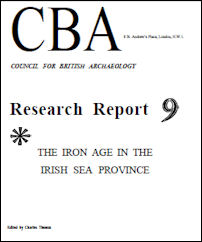CBA Research Reports
Council for British Archaeology, 2000. (updated 2020) https://doi.org/10.5284/1000332. How to cite using this DOI
Data copyright © Council for British Archaeology unless otherwise stated
This work is licensed under the ADS Terms of Use and Access.
Primary contact
Council for British Archaeology
92 Micklegate
York
YO1 6JX
UK
Tel: 01904 671417
Resource identifiers
- ADS Collection: 281
- DOI:https://doi.org/10.5284/1000332
- How to cite using this DOI
The Iron Age in the Irish Sea Province: papers given at a CBA conference held at Cardiff, January 3 to 5, 1972
Charles Thomas (editor)
CBA Research Report No 9 (1972)
Abstract

Papers given at a CBA conference held at Cardiff, January 3-5, 1969, are introduced by Joseph Raftery, who outlines the problems needing research (pp 1-10). In Ireland the chief priority is to find habitations and burials to provide a context for the isolated metalwork finds. There is so far no fixed chronological point, but a rough sequence appears thus: c 200 BC a transitional period, still LBA in essentials; then native production of La Tène style bronzes to c AD 0; then a romanising period of unknown length. For Wales, with its apparently non-native metalwork, the submission is that EIA evidence is even more tenuous. Welsh-Irish contacts were intermittent and small-scale, and the Irish Sea traffic was north-south rather than west-east.
Contents
- Title pages (pp i-vi)
- List of Plates (p iv)
- Editor's Foreword (p v)
- List of Contributors (p vi)
- Iron Age and Irish Sea: problems for research by Joseph Raftery (p 1)
- Hill-forts in the coastal area of Wales by A H A Hogg (p 11)
- Welsh border hill-forts by S C Stanford (p 25)
- Irish hill-forts by Barry Raftery (p 37)
- The chariot as described in Irish literature by David Greene (p 59)
- Souterrains in the Irish Sea province: a note by Charles Thomas (p 75)
- Celtic stone idols in Ireland by Etienne Rynne (p 79)
- The Irish Sea zone in the Pre-Roman Iron Age by Leslie Alcock (p 99)
Download report
| The Iron Age in the Irish Sea Province: papers given at a CBA conference held at Cardiff, January 3 to 5, 1972 (CBA Research Report 9) | 2 Mb |







